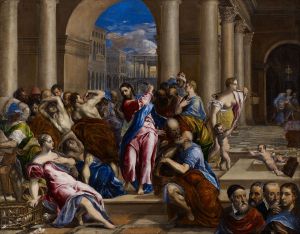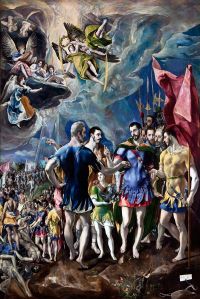

The Burial of the Count of Orgaz (El Greco) (Wikipedia*)
If, like me, you like art but you haven’t studied it, you might also think of El Greco (Domenikos Theotokopoulos, 1541-1614) as a rather gloomy painter. I’ve seen his paintings in the Prado in Madrid and in the Palazzo Barbarini in Rome and also in situ at the church of Santo Tomé in Toledo where ‘The Burial of the Count of Orgaz’ is the centrepiece of the chapel wall. There’s also an El Greco at the NGV: it’s called ‘Portrait of a Cardinal’ and it was purchased through the Felton Bequest in 1950. You can see it here.
My take-home impression of this artist is that he painted lots of sombre noblemen in black outfits with the obligatory white ruffles, and lots of even more sombre religious paintings in very sombre colours indeed. Even allowing for the deterioration of what might have once been brighter paint colours, El Greco seems depressing.
Which is why, when I saw this book at the library, I was quite taken aback by the portrait on the front cover of this book. ‘Lady in a Fur Wrap’ is quite unlike any of the other El Greco portraits I’ve seen, and — as it turns out — also unlike the ones in this book. The painting is discussed in the chapter ‘Posthumous Fame in Spain’ where there is discussion about the extent to which El Greco’s son, Jorge Manuel Theotokopoulos (1578-1631) was responsible for finishing some of his father’s paintings after his death in 1614. And hmm, it seems to me to be a bit cheeky to put ‘Lady in a Fur Wrap’ on the front cover of a book about El Greco, because…
Recent research dates the work to the 1570s. Yet there are weighty arguments for considering it not a work of El Greco’s at all but from the hand of a female artist, Sofonisba Anguissola (1535/40-1625).
So this painting on the front cover of a book about El Greco, probably wasn’t his work at all! And from what I can see of her work at Wikipedia, she was a fine portraitist and if I ever get to go back to the Prado, I’m going to look out for the paintings that are now recognised as being painted by her.
Anyway…
This book is one of a series called Basic Art 2.0, and according to its blurb the series has evolved from its beginnings in 1985 with the title ‘Picasso’, to being the best-selling art book collection ever published. Listed at the back of this book there are 62 more titles representing artists from Bacon to Warhol, as well as 12 books on art genres from Abstract Impressionism to The Blaue Reiter (which was a movement of German Expressionists.) There are also 18 books about architecture, from Aalto to Zaha Hadid.
El Greco, a Prophet of Modernism measures about 26cm x 21cm and most of its 95 pages are full page, full colour reproductions of his art works. There are 9 chapters in which Scholz-Hänsel covers these self-explanatory topics:
- From Icon Painter to ‘Disciple of Titian’
- In Search of Work in Rome and Spain
- Under the Sway of Michelangelo
- Censorship and Inquisition
- Toledo, the Artist’s New Home
- The Greek Heritage in the Conflict of Confessions
- Posthumous Fame in Spain
- The First ‘Homeless Man of Art’ and the Avant-Garde
- El Greco 1541-1614 Life and Work (a timeline of his life)
There are three reasons why El Greco is the best-known foreign artist of his period, yet we know much less about him than many lesser Italian artists of the post-Renaissance era. Firstly, he made a long ‘pilgrimage’ through the Mediterranean before finally settling in Toledo in Spain in 1577. Secondly, it was not until the 17th century that Spanish writers on art emerged, and thirdly, until Goya, there was no Spanish school of engraving, so his works weren’t reproduced as prints. Still, recent research has uncovered all kinds of useful documentation, which helps to fill out the picture. Nobody is quite certain which religion he practised, but he probably trained in icon painting in a ‘hybrid’ Byzantine school. He quickly gained a reputation as a master in this field, and he soon started to experiment beyond the traditional motifs. There are some stunning triptychs in this chapter, on view, apparently in Modena.

Retrato de Vincenzo Anastagi (El Greco) (Wikipedia*)
By 1570 he was in Rome, painting remarkable portraits. Some of these like the one of Vincenzo Astagi at right look so modern they might well be 19th century portraits, (except for the bloomers). However most of his religious paintings feature people in dowdy green, grey and wishy-washy blue clothing and they have long faces with very sour expressions and grey skin tones. ‘The Purification of the Temple’, painted in 1570-75 (and held at the Minneapolis Institute of Arts) makes Jesus look painfully vengeful. He has no halo, and his expression reminds me more of a sulky young thug than the Son of God upholding the sanctity of the temple.

However El Greco made himself very unpopular by offering to paint over Michelangelo’s nudes in the Sistine Chapel in accord with more strict Catholic dogma. This was such a bad idea that he was forced to leave the city. (And a good thing too, IMO… just imagine if he’d succeeded with his plans!)
By 1580 he’d shed naturalism, and began to express spiritual phenomena…

His works of the 1580s show an increasing disregard for Renaissance rules of perspective and proportion. The figures lose plasticity, become slender and elongated. As we know from Pacheco, El Greco prepared his compositions not with live models but, like Tintoretto, with clay figurines. The illumination took on a symbolic function, light and dark came to stand in a marked contrast to each other, and the colours began to take on a more expressive character.
At right is the painting that Scholz-Hänsel has chosen to show this astonishing change in style… it’s the ‘Martyrdom of St Maurice, 1580-82, held in the Monasterio de San Lorenzo de El Escorial, Patrimonio Nacional, and it’s interesting for a whole lot of reasons including that we can see in the foreground Maurice (in the blue tunic) meeting the legionnaires and if you look in the LH middleground, there he is again, comforting someone else about to be beheaded. (BTW Does anyone else find the stance of the legionnaires in this picture a little odd? It looks more like an invitation to dance than an arrest.)
The chapter called ‘Toledo, the Artist’s New Home’ has quite a bit about ‘The Burial of the Count of Orgas’ because it’s El Greco’s best known painting. By now he had abandoned the concepts of the Roman High Renaissance by using light for symbolic effects. If you look back up at the painting at the top of this post, you can see that the heavenly sphere is dominated by a restless oblique light, while the earthly realm confronts the viewer as a uniformly illuminated stage on which the roches, surprisingly, seem to give off little real light. The Wikipedia image shows the painting at its best, obviously photographed under strong lights. It doesn’t look like that in a small church where the lighting isn’t very good anyway and the effect is melancholy indeed. Scholz-Hänsel says in a later chapter that Picasso’s painting ‘Burial of Casamagas’ was influenced by this painting and that Picasso strongly identified with El Greco even as late as his Pink Period.
I find it interesting that Scholz-Hänsel argues that it was intellectuals and the international art avant-garde who resurrected interest in El Greco, after he had long fallen out of favour, his works judged affected and exaggerated. He quotes the Spanish artist Palomino (1625-1726) as saying ‘But when he saw that his paintings were confused with those of Titian, he attempted to change his style with such extravagance that he made his painting inferior and ridiculous both in the distortions of drawing and the insipidness of colour.’ (p.89)
And that’s what I think too.
Image credits:
- ‘The Burial of the Count of Orgaz’ View of the painting by El Greco in the church of Santo Tomé, Wikipedia, public domain,
- Retrato de Vincenzo Anastagi (El Greco) – Web Gallery of Art: Image Info about artwork, Public Domain,
- The Martydom of St Maurice (El Greco) – Colecciones reales, Patrimonio Nacional de España, Public Domain, Wikipedia
Author: Michael Scholz-Hänsel
Title: El Greco, Domenikos Theotokopoulos, 1541-1614, a Prophet of Modernism
English edition translated by John Gabriel
Basic Art Series 2.0
Publisher: Taschen, 2016, 95 pages
ISBN: 9783836534536
Source: Kingston Library
Available from Fishpond: El Greco $28.05 (which seems much cheaper than most art books that I see). Fishpond seem to have quite a few of these titles, search Taschen Art Series or see here. They vary in price, but there are also some second-hand copies which are considerably cheaper.


They put pictures of pretty ladies on the covers of books or chocolate boxes in order to sell the books or the chocs.
LikeLiked by 1 person
By: carmelbird on September 7, 2019
at 9:16 am
True. But this is beyond deceptive, don’t you think?
LikeLike
By: Lisa Hill on September 7, 2019
at 11:13 am
We saw El Greco at the Prado museum in Madrid recently. Our guide talked of him along with two other Spanish painters who were recommended to look out for. I found his paintings to be dark but interesting. There is an app I have on my tablet called Daily Art that features a different painting each day with a paragraph or two about it. The art is from all over the world and you never know what will pop up. You may enjoy it and it’s free. I google some of them for more information if of interest.
LikeLike
By: TravellinPenguin on September 7, 2019
at 9:38 am
That sounds interesting. I follow three blogs about art, and they’re good too. They’re all written by proper experts and vary what they do by sometimes focussing on an artist, and other times on a medium or a style. One recently did a series on paintings in the Tretyakov gallery in Moscow which was excellent because this is a terrific gallery but hardly anybody knows about it because if they go to Russia at all, they visit the Hermitage in St Petersburg.
LikeLike
By: Lisa Hill on September 7, 2019
at 11:16 am
I’ll be in Moscow the end of this month but not sure yet what galleries we are visiting. I’ll keep this in mind.
LikeLike
By: TravellinPenguin on September 8, 2019
at 6:18 am
Have a look here for posts about the Tretyakov https://mydailyartdisplay.wordpress.com/category/tretyakov-gallery/ and here for my travel blog posts about Moscow: https://hillfamilysoutherndivision.wordpress.com/category/destinations/europe/europe-2012/russia-2012/moscow-2012/
I wish I were coming with you, my Russian holiday was one of the best I’ve ever had:)
LikeLike
By: Lisa Hill on September 8, 2019
at 12:40 pm
Thank you Lisa. 🤠🐧
LikeLike
By: TravellinPenguin on September 9, 2019
at 1:49 pm
[…] El Greco, by Michael Scholz-Hänsel, (English edition) translated by John Gabriel […]
LikeLike
By: Nonfiction November – My Year in Nonfiction | ANZ LitLovers LitBlog on November 1, 2019
at 7:13 pm